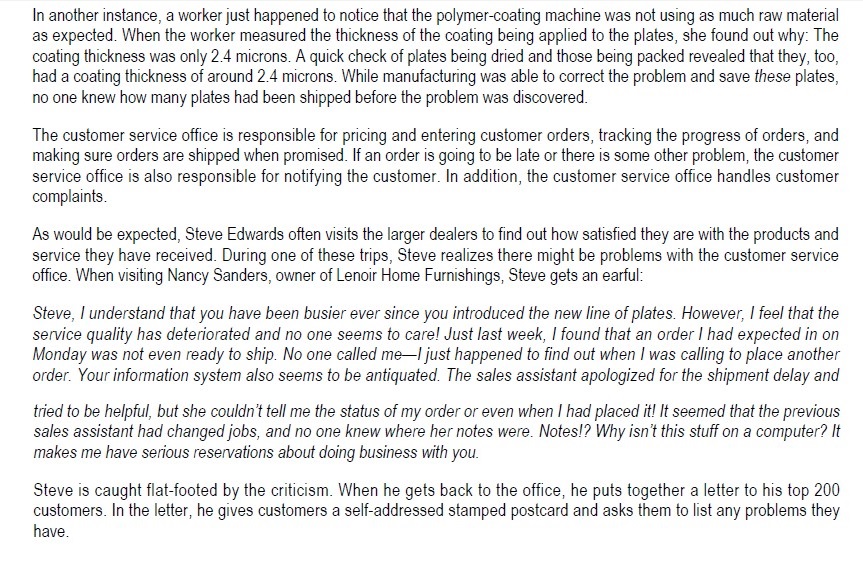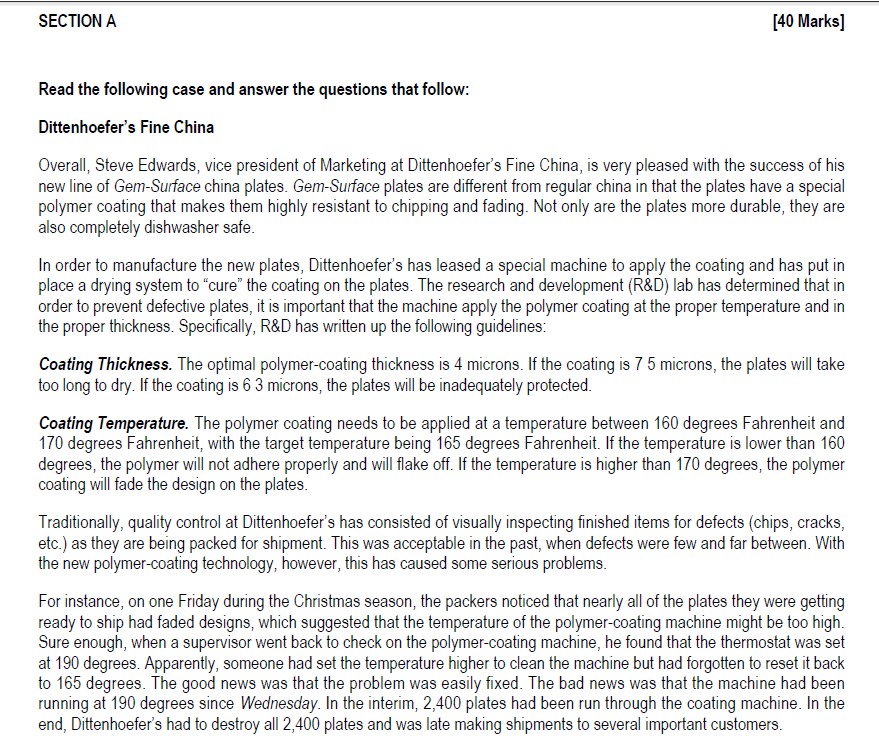SUPPLY CHAIN MANAGEMENT
In another instance, a worker just happened to notice that the polymer-coating machine was not using as much raw material as expected. When the worker measured the thickness of the coating being applied to the plates, she found out why: The coating thickness was only 2.4 microns. A quick check of plates being dried and those being packed revealed that they, too, had a coating thickness of around 2.4 microns. While manufacturing was able to correct the problem and save these plates, no one knew how many plates had been shipped before the problem was discovered The customer service office is responsible for pricing and entering customer orders, tracking the progress of orders, and making sure orders are shipped when promised. If an order is going to be late or there is some other problem, the customer service office is also responsible for notifying the customer. In addition, the customer service office handles customer complaints. As would be expected, Steve Edwards often visits the larger dealers to find out how satisfied they are with the products and service they have received. During one of these trips, Steve realizes there might be problems with the customer service office. When visiting Nancy Sanders, owner of Lenoir Home Furnishings, Steve gets an earful: Steve, I understand that you have been busier ever since you introduced the new line of plates. However, I feel that the service quality has deteriorated and no one seems to care! Just last week, I found that an order I had expected in on Monday was not even ready to ship. No one called me-I just happened to find out when I was calling to place another order. Your information system also seems to be antiquated. The sales assistant apologized for the shipment delay and tried to be helpful, but she couldn't tell me the status of my order or even when I had placed it! It seemed that the previous sales assistant had changed jobs, and no one knew where her notes were. Notes!? Why isn't this stuff on a computer? It makes me have serious reservations about doing business with you. Steve is caught flat-footed by the criticism. When he gets back to the office, he puts together a letter to his top 200 customers. In the letter, he gives customers a self-addressed stamped postcard and asks them to list any problems they have.sscnorvw [4o Marks] Read the following case and answer the questions that follow: Dittenhoefer's Fine China Overall, Steve Edwards, vice president of Marketing at Dittenhoefer's Fine China, is very pleased with the success of his new line of GemSurface china plates. GemSurface ptates are different from regular china in that the plates have a special polymer coating that makes them highly resistant to chipping and fading. Not only are the plates more durable, they are also completely dishwasher safe. In order to manufacture the new plates, Dittenhoefer' s has leased a special machine to apply the coating and has put in place a drying system to n'cure" the coating on the plates- The research and development {RED} lab has determined that in order to prevent defective plates, it is important that the machine apply the poiymer coating at the proper temperature and in the proper thickness. Specicaily, RM) has written up the following guidetines: Coating Thickness. The optimal polymercoating thickness is 4 microns. If the coating is i' 5 microns, the plates will take too long to dry. If the coating is E 3 microns, the plates will be inadequateiy protected. Coating Temperature. The polymer coating needs to be applied at a temperature between 160 degrees Fahrenheit and 1H] degrees Fahrenheit, with the target temperature being 165 degrees Fahrenheit. if the temperature is lower than 160 degrees, the polymer will not adhere properly and will flake off. If the temperature is higher than 1TB degrees, the polymer coating will fade the design on the plates. Traditionally, quatity control at Dittenhoefer's has consisted of visually inspecting nished items for detects (chips, cracks, etc.) as they are being packed for shipment. This was acceptable in the past, when defects were few and far between. With the new potymercoating technology, however, this has caused some serious problems. For instance, on one Friday during the Christmas season, the packers noticed that nearly all of the ptates they were getting ready to ship had faded designs, which suggested that the temperature of the polymercoating machine might be too high. Sure enough, when a supervisor went back to check on the polymercoating machine, he found that the thermostat was set at 190 degrees. Apparently, someone had set the temperature higher to ciean the machine but had forgotten to reset it back to 165 degrees. The good news was that the problem was easiiy xed. The bad news was that the machine had been running at 190 degrees since Wednesday. In the interim, 2,4tl plates had been run through the coating machine. In the end, Dittenhoefer's had to destroy all 2,400 plates and was late making shipments to several important customers








